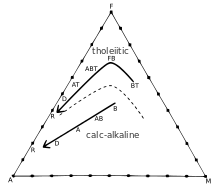Calc-alkaline magma series
The calc-alkaline magma series is one of two main subdivisions of the subalkaline magma series, the other subalkaline magma series being the tholeiitic. A magma series is a series of compositions that describes the evolution of a mafic magma, which is high in magnesium and iron and produces basalt or gabbro, as it fractionally crystallizes to become a felsic magma, which is low in magnesium and iron and produces rhyolite or granite. Calc-alkaline rocks are rich in alkaline earths (magnesia and calcium oxide) and alkali metals and make up a major part of the crust of the continents.
The diverse rock types in the calc-alkaline series include volcanic types such as basalt, andesite, dacite, rhyolite, and also their coarser-grained intrusive equivalents (gabbro, diorite, granodiorite, and granite). They do not include silica-undersaturated, alkalic, or peralkaline rocks.
Geochemical characterization

Rocks from the calc-alkaline magma series are distinguished from rocks from the tholeiitic magma series by the redox state of the magma they crystallized from (tholeiitic magmas are reduced, and calc-alkaline magmas are oxidized). When mafic (basalt-producing) magmas crystallize, they preferentially crystallize the more magnesium-rich and iron-poor forms of the silicate minerals olivine and pyroxene, causing the iron content of tholeiitic magmas to increase as the melt is depleted of iron-poor crystals. (Magnesium-rich olivine solidifies at much higher temperatures than iron-rich olivine.) However, a calc-alkaline magma is oxidized enough to (simultaneously) precipitate significant amounts of the iron oxide magnetite, causing the iron content of the magma to remain more steady as it cools than with a tholeiitic magma.
The difference between these two magma series can be seen on an AFM diagram, a ternary diagram showing the relative proportions of the oxides of Na2O + K2O (A), FeO + Fe2O3 (F), and MgO (M). As magmas cool, they precipitate out significantly more iron and magnesium than alkali, causing the magmas to move towards the alkali corner as they cool. In the tholeiitic magma, as it cools and preferentially produces magnesium-rich crystals, the magnesium content of the magma plummets, causing the magma to move away from the magnesium corner until it runs low on magnesium and simply moves towards the alkali corner as it loses iron and (relic) magnesium. With the calc-alkaline series, however, the precipitation of magnetite causes the iron-magnesium ratio to remain relatively constant, so the magma moves in a straight line towards the alkali corner on the AFM diagram.
Calc-alkaline magmas are typically hydrous, and also typically are more oxidized, with higher oxygen fugacities.
Geologic context
Calc-alkaline rocks typically are found in the arcs above subduction zones, commonly in volcanic arcs, and particularly on those arcs on continental crust.
Petrologic origin
Rocks in the series are thought to be genetically related by fractional crystallization and to be at least partly derived from magmas of basalt composition formed in the Earth's mantle. Trends in composition can be explained by a variety of processes. Many explanations focus on water content and oxidation states of the magmas. Proposed mechanisms of formation begin with partial melting of subducted material and of mantle peridotite (olivine and pyroxene) altered by water and melts derived from subducted material. Mechanisms by which the calc-alkaline magmas then evolve may include fractional crystallization, assimilation of continental crust, and mixing with partial melts of continental crust.
See also
References
- Barker, Daniel S. (1983). Igneous Rocks. Englewood Cliffs, NJ: Prentice Hall, Inc. p. 417.
Further reading
- Peacock, M. A. (1931). "Classification of igneous rock series". Journal of Geology. 39: 54–67. Bibcode:1931JG.....39...54P. doi:10.1086/623788.
- Rittmann, Alfred (1962). Volcanoes and their activity. New York: John Wiley & Sons, Inc. p. 305, translated by EA Vincent from the 1960, 2 ed.
- Sheth, Hetu; Torres-Alvarado, Ignacio; Verma, Surendra (August 2002). "What Is the "Calc-alkaline Rock Series"?". International Geology Review. 44 (8): 686–701. doi:10.2747/0020-6814.44.8.686.
Two of these widely used diagrams are the total alkalies-silica (TAS) diagram and the (Na2O + K2O)-FeO*-MgO (AFM) triangular diagram, neither of which has calcium as one of the plotting parameters... Not all orogenic andesites are calc-alkaline, and not all calc-alkaline andesites are orogenic
- Le Maitre, R. W.; Streckeisen, A.; Zanettin, B.; Le Bas, M. J.; Bonin, B.; Bateman, P., eds. (January 2005). Igneous Rocks: A Classification and Glossary of Terms: Recommendations of the International Union of Geological Sciences, Subcommission on the Systematics of Igneous Rocks. Cambridge, UK: Cambridge University Press. p. 252. ISBN 0-521-61948-3.
- Arculus, Richard J. (2003). "Use and abuse of the terms calcalkaline and calcalkalic". Journal of Petrology. 44: 929–935. doi:10.1093/petrology/44.5.929.
The terms calcalkaline and calcalkalic are currently defined and used in multiple and non-equivalent ways. Generally, the variation of total Fe as FeO/MgO within evolving subalkaline rock suites is regarded as the most distinctive character of calcalkaline compared with tholeiitic suites, reflecting the relative timing of phase saturation with Fe–Ti oxides, plagioclase, and ferromagnesian silicates. Other classification schemes are widely used, including a minority of adherents to the original formalized definition of ‘calcalkalic’ by Peacock (1931, Journal of Geology 39, 54–67). Given the prevailing contradictory and confusing usage of these terms, which leads to miscommunication, it is proposed that the spectrum of subalkaline rocks be divided into high-, medium-, and low-Fe suites, complementing divisions made on the basis of K contents. The terms calcalkaline and calcalkalic should be restricted to rock suites that conform to Peacock's definition.